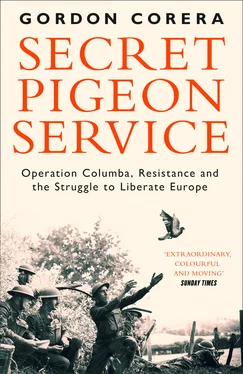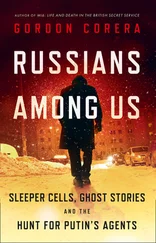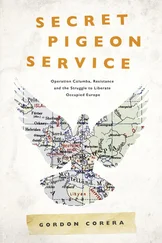At a table underneath a light in the safe room, Raskin pored over the drawings and details that came in, the spider at the centre of a web of espionage. The drafts of the maps and notes have miraculously survived, pages and pages of them, different types of notepaper and different handwriting reflecting the many hands that contributed to the work. Space was tight. Everything had to fit on two pages, and that meant decisions. Like a ruthless sub-editor at a newspaper, Raskin scribbled out lines with black pen where he thought the detail was superfluous. A line about the Germans taking too many potatoes from people is crossed out, as are general complaints about poverty and life being expensive. That was not hard intelligence, he knew. The next line of a draft, though, stayed in for the moment – how the Germans went from carriage to carriage on trains taking food from people, sometimes even slurping raw eggs. Also retained was a line about how people were taking the copper of phone cables between Bruges and Ghent. A line about how people longed for the English and would point out the blackshirts was scribbled out. Raskin was careful to stick to the exam question – answering the specific queries that the pigeon had carried to them and not inserting extraneous information.
The pigeon sat just round the corner at the ready. For Raskin, it may have represented something more than just a messenger. The pigeon – referred to by its proper name, the dove – has a powerful symbolic role in Christianity. When Jesus was baptized by John the Baptist, ‘the Holy Spirit descended on him in bodily form like a dove. And a voice came from heaven: “You are my Son, whom I love; with you I am well pleased.”’ This dove had come to Belgium from Britain; but perhaps, for Raskin, it had come spiritually as well as literally from above. Faith, duty and spying were all intertwined in the priest’s mind.
Material was still coming in as he wrote. The Germans were strengthening their positions on the coast, fearing an English attack. A new division had been installed and there was extensive activity from planes as well as lorries bringing in fuel. Advice was offered as well – if the British were planning to invade then they should avoid delay in moving through the country or the Germans would take all the able-bodied men to Germany. No one had any idea that it would take three long years for the British to arrive.
Finally, he was ready. Raskin took his pen and began the final draft, working through the night of 11 July. He sat at the desk with a magnifying glass to ensure he could cram in as much detail as possible on the tiny sheets of paper. The quill of his pen was precise. Every space would be put to use. A last-minute item of intelligence came in on the morning of 12 July at five minutes to eight. Joye had come through Bruges railway station and had seen a ground air defence post moved. That detail was added in the corner.
Raskin finished with a flourish and a special touch. ‘Our seal!’ he wrote in the bottom corner, adding a symbol which he intended to be a unique identifier of the group and its future messages. It was a circle with a curly L sitting in a V, one side of the V becoming either a cross or a sword, depending on how you interpreted it. Their name was Leopold Vindictive.
There was no more space. The message was ready to fly. The two pieces of rice paper were carefully folded up and placed inside the green cylinder that had come with the pigeon. The cylinder was slotted into the ring around the pigeon’s feet and twisted to secure it.
The group then did something extraordinary, an act contrary to every rule of spycraft. They picked up their family camera and took pictures of the pigeon, and of the message being pushed into the green cylinder. But then, even more extraordinarily, the three brothers and two sisters stood for a family portrait in the inner courtyard. Marie and Margaret are in their aprons, Michel and Gabriel in working shirts with braces. Arseen looks somewhat smarter. At first sight, it could be any other family picture, but look more closely and you can see that Marie, the elder sister, is holding a resistance newspaper, Margaret is holding what looks like a white sheet – the parachute. Arseen holds a pencil, Gabriel the British intelligence questionnaire, and Michel proudly clutches the pigeon. And in front of them, propped against a table with a white tablecloth, is a chalkboard – probably the board that they would normally use to display the latest fruit and vegetable prices for shoppers. But this time, on the board are written the dates of the bird’s arrival and departure, its ring number and the phrase ‘Via Engeland’ to mark its destination. And at the top are three capital V’s – the symbol of Victory, which earlier that year the BBC had called on people to daub on walls as a symbol of defiance.
Taking the photos was a mad, risky and amateurish thing to do, and yet it spoke of something that is impossible to criticize – a deep pride in their work of resistance. Raskin is not in the picture, most likely because he was on the other side of the camera taking it.
There was one final picture to be taken. Michel climbed up onto the roof, where there was an oat-attic. This was the place from which he normally released his pigeons, and so it may have looked less suspicious than it sounds to anyone watching him. Up there he opened his cupped hands and released the bird; a picture captures the precise moment. At 8.15 a.m. the bird rose high into the sky and circled for a few moments to get its bearings. Then it made for the Channel and for England. In seven hours’ time it would have escaped Nazi-occupied Europe and be home in suburban Ipswich.
CHAPTER FOUR
It took thirty-six hours from Michel’s release of the pigeon on the roof in Lichtervelde for Raskin’s elegant message to reach the hands of British intelligence. The pigeon, which had left Britain on 5 July and was released from Belgium at 8.15 a.m. on 12 July, flew over the English Channel and was back at its loft in suburban Ipswich – about ten miles from the coast – by 3.30 that afternoon. All it knew was that it was home.
Loft owners had been ordered to keep a sharp eye out for the return of a bird, even though they were told nothing of its mission. As soon as a pigeon arrived, they were to take off the Bakelite cylinder, which was about the size of a pen top, attached to its legs. Well-to-do owners might have their own phone and be able to call the special number. But otherwise a child might be sent on a bike with the cylinder to the local pigeon supply officer, who would call in the delivery. Then they would wait. In some cases the roar of a motorcycle dispatch rider could be heard outside in just twenty minutes. The cylinder would be handed over and rushed to London. The orders were strict – cylinders were never to be opened by anyone until they arrived at the War Office. This was partly because the contents were secret, but more so because they were often written in pencil and folded up so tight that they had to be carefully extracted without being ripped or smudged. If that happened, someone would have risked his or her life for nothing.
On the morning of 13 July, the message arrived in London at Room 25 of the War Office. Sanderson and Melland were both on duty that day and early in the war they opened the messages themselves. ‘I well remember the fascination of opening these little tubes and unwinding the thin slips of paper which they contained,’ Melland later said. When the pigeon service first began, it was feared that the tiny cylinders might be booby-trapped. And so Melland and Sanderson would open them with a sheet of protective glass in front of their faces in order to guard against any ‘tricks’. Fortunately, they never had a cylinder explode in their face (although Bert Woodman in Plymouth said he heard that at least one cylinder had been found with explosives). Once a cylinder was open, they would translate the message into English, enter its details in a log book and then distribute the information round other departments.
Читать дальше












